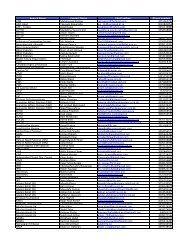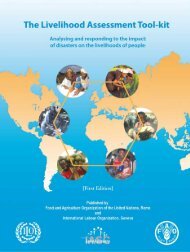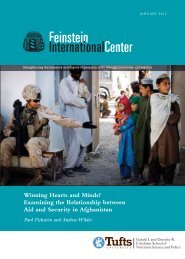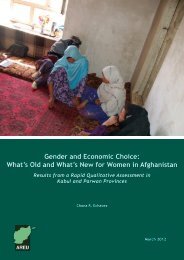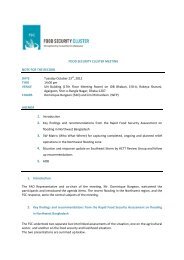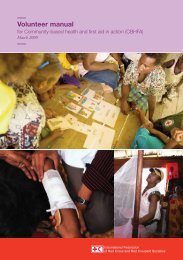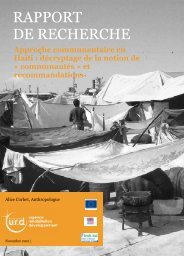IASC Reference Module for Cluster Coordination at the ... - Clusters
IASC Reference Module for Cluster Coordination at the ... - Clusters
IASC Reference Module for Cluster Coordination at the ... - Clusters
Create successful ePaper yourself
Turn your PDF publications into a flip-book with our unique Google optimized e-Paper software.
6 Sub-N<strong>at</strong>ional Level <strong>Coordin<strong>at</strong>ion</strong>Sub-n<strong>at</strong>ional coordin<strong>at</strong>ion refers to de-centralizing coordin<strong>at</strong>ion from <strong>the</strong> n<strong>at</strong>ional levelby establishing sub-clusters/sectors in zones of particular oper<strong>at</strong>ional importance.Structures may be established <strong>at</strong> more than one administr<strong>at</strong>ive level if required (e.g.provinces and districts in Pakistan), although <strong>the</strong> underlying principle of minimizingstructures remains firmly in place. Sub-n<strong>at</strong>ional coordin<strong>at</strong>ion is critical where <strong>the</strong>response take place in remote areas (e.g. in Sudan) or over a large amount of territory(e.g. in <strong>the</strong> DRC).Importance ofsub-n<strong>at</strong>ionalcoordin<strong>at</strong>ion<strong>Coordin<strong>at</strong>ion</strong> structures in humanitarian oper<strong>at</strong>ions th<strong>at</strong> involve both n<strong>at</strong>ional and subn<strong>at</strong>ionallevel clusters have been identified as more effective than coordin<strong>at</strong>ion modelsth<strong>at</strong> comprise a single n<strong>at</strong>ional level cluster. Notwithstanding resource limit<strong>at</strong>ions andoper<strong>at</strong>ional context consider<strong>at</strong>ions, it is highly desirable to have sub-n<strong>at</strong>ional clustersto facilit<strong>at</strong>e decentralized decision-making and enhance <strong>the</strong> response time betweendecision-taking and implement<strong>at</strong>ion. In addition, sub-n<strong>at</strong>ional level clusters are bettersuited to adapting existing standards to local circumstances. They are also betterplaced to maintain close cooper<strong>at</strong>ion with intern<strong>at</strong>ional, n<strong>at</strong>ional and local NGOs andauthorities in implementing <strong>the</strong> str<strong>at</strong>egic plan; paying <strong>at</strong>tention to cross-cutting andmultidimensional issues; ensuring gre<strong>at</strong>er community involvement and particip<strong>at</strong>ion;and enhancing accountability to affected popul<strong>at</strong>ions.However, as outlined above, sub-n<strong>at</strong>ional clusters should only be established on <strong>the</strong>basis of <strong>the</strong> oper<strong>at</strong>ional needs and should be de-activ<strong>at</strong>ed as soon as those needs aremet or when <strong>the</strong>re is local capacity to coordin<strong>at</strong>e <strong>the</strong> response in th<strong>at</strong> area.Sub-n<strong>at</strong>ionalclusterestablishmentThe establishment of sub-n<strong>at</strong>ional clusters should be <strong>for</strong>malized in terms of referenceoutlining <strong>the</strong> key functions of <strong>the</strong> sub-n<strong>at</strong>ional cluster and <strong>the</strong> parameters within whichit will oper<strong>at</strong>e. The agreed terms of reference should be shared with <strong>the</strong> n<strong>at</strong>ional<strong>Cluster</strong> Lead Agency <strong>for</strong> final endorsement.Within <strong>the</strong> limits of available resources and oper<strong>at</strong>ional context, sub-n<strong>at</strong>ional clustersshould have full- or part-time sub-n<strong>at</strong>ional level <strong>Cluster</strong> Coordin<strong>at</strong>ors. Sub-n<strong>at</strong>ionalclusters offer ideal opportunities <strong>for</strong> UN agencies, intern<strong>at</strong>ional and n<strong>at</strong>ional NGOs aswell as n<strong>at</strong>ional authorities to share cluster leadership.Rel<strong>at</strong>ionshipbetween n<strong>at</strong>ionaland sub-n<strong>at</strong>ionalclustersThe n<strong>at</strong>ional level clusters should provide support and policy direction to sub-n<strong>at</strong>ionalclusters. There must be a clear link between corresponding sub-n<strong>at</strong>ional and n<strong>at</strong>ionalclusters in order to facilit<strong>at</strong>e reporting, in<strong>for</strong>m<strong>at</strong>ion-sharing and collabor<strong>at</strong>ion withn<strong>at</strong>ional and o<strong>the</strong>r sub-n<strong>at</strong>ional level clusters; to promote n<strong>at</strong>ional programm<strong>at</strong>iccohesion and overall coordin<strong>at</strong>ion to track trends; to identify common concerns acrossoper<strong>at</strong>ional areas; and to develop more upstream advocacy and programmingstr<strong>at</strong>egies. To ensure this coherence, <strong>the</strong> terms of reference should establish clearaccountability lines between n<strong>at</strong>ional and sub-n<strong>at</strong>ional clusters, thus enabling <strong>the</strong>decentraliz<strong>at</strong>ion of oper<strong>at</strong>ional decisions. There should also be a clearly understoodsequencing between n<strong>at</strong>ional and sub-n<strong>at</strong>ional bodies: n<strong>at</strong>ional meetings should takeplace after sub-n<strong>at</strong>ional meetings and both discussions should be based on a reliablerecord of decisions taken and issues raised.<strong>Cluster</strong> <strong>Coordin<strong>at</strong>ion</strong> <strong>Reference</strong> <strong>Module</strong> | 2012 16



